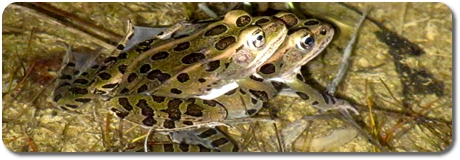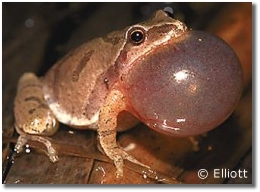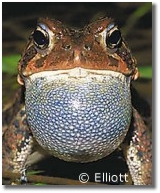Amphibian Life Cycles
STARTING FROM AN EGG
All amphibians start life as an egg in a ball of jelly. In spring adult males and females gather in ponds, lakes or streams to mate. Male frogs, treefrogs and toads climb on the backs of females and hold on. This is called "amplexus", which is Latin for "embrace". Amphibians have a cloaca where both their eggs or sperm and waste (poop) comes out. When the female lays eggs the male releases sperm to fertilize them in the water. Male salamanders put a packet of sperm in front of a female. She picks it up through her cloaca and fertilizes her eggs inside her body before they are laid in the water.

Leopard Frogs in amplexus.
After the eggs are laid the adults leave them. They do not take care of their young. Each egg grows to become a tiny young amphibian that breaks out of the jelly. Most look like a little fish when they hatch out. We call the young of amphibians a "larva" (more than one are "larvae") because they do not look like the adults. The young of a frog, toad or treefrog is usually called a tadpole. The young of a salamander is usually called a larva.
A young amphibian has gills to breathe underwater and a tail with a fin so it can swim. When it gets bigger it starts to grow legs. When it is full grown it changes quickly to its adult body shape. It loses its gills and grows lungs to breathe air. It loses its tail fin and its legs grow much larger. Then it leaves the water to live on land. It looks like an adult now, only much smaller. Small frogs, toads and treefrogs can be called froglets, toadlets and treefroglets! (A more scientific term is "metamorphs".) Small salamanders are called juveniles.
It takes a couple of years for an amphibian to grow to its adult size. Then they will return to ponds, lakes or streams in spring to look for a mate to start the cycle over again.
HOW OLD
Most frogs, toads and treefrogs live for 5 to 10 years. Some pet toads have lived for 40 years! Salamanders can live for more than 10 years. A captive Japanese Giant Salamander lived more than 50 years!
WHERE THEY BREED
All of our amphibians lay their eggs in water usually near the habitat where they live. Most lay their eggs in small ponds where there are no fish to eat the eggs or larvae. Some amphibians breed in temporary ponds that fill with water from melting snow in spring or heavy rains in summer. They can live in places where there is no permanent water for part of the year. Some amphibians have young that take a long time to grow up so they must lay their eggs in water bodies that don't dry up. These amphibians can never live far from water.
You will learn more when you read about each kind of amphibian.

Mating Calls
The croak of a frog, toad or treefrog is the sound that a male makes so a female can find him and mate with him.
 |
Hear this Spring Peeper: |
To make the sound, air is pushed into the mouth. The skin on the bottom or sides of the mouth swells up like a balloon. The sound starts in the voice box and bounces back and forth off the stretched skin. This makes the sound much louder.
| Hear this American Toad: |  |
Every different kind of frog, toad, or treefrog makes its own special sound. You can hear these when you visit their page.
Next: Reptile Life Cycles
Or back to: About Amphibians and Reptiles or the Front Page
